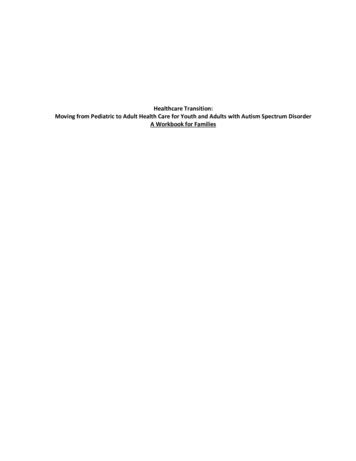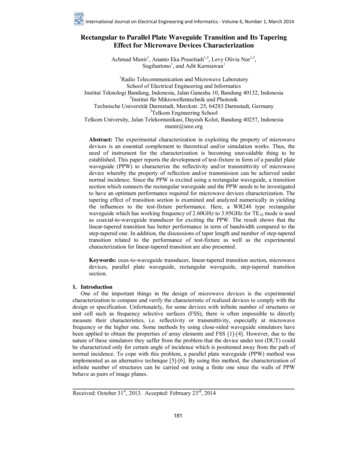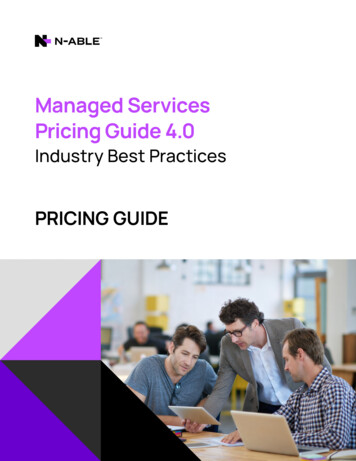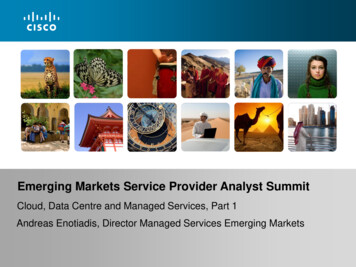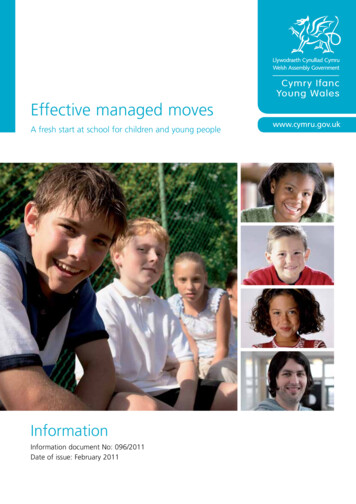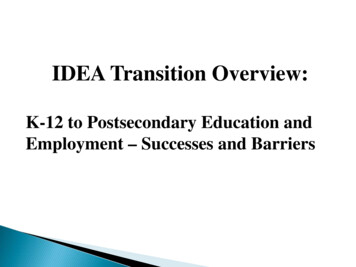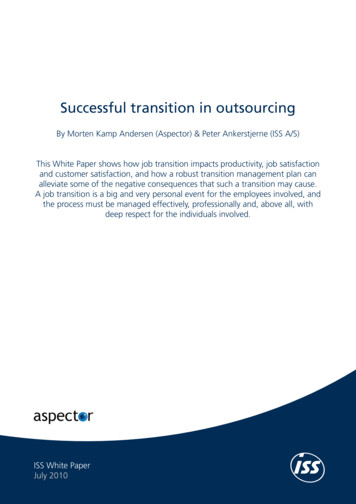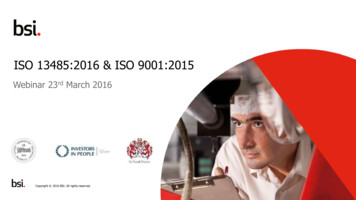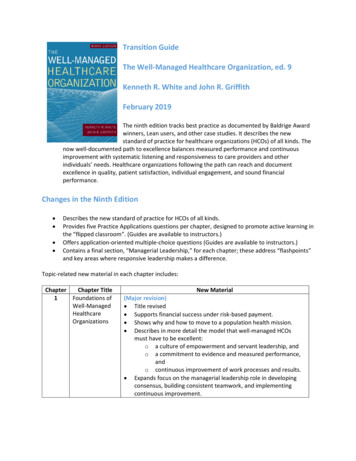
Transcription
Transition GuideThe Well-Managed Healthcare Organization, ed. 9Kenneth R. White and John R. GriffithFebruary 2019The ninth edition tracks best practice as documented by Baldrige Awardwinners, Lean users, and other case studies. It describes the newstandard of practice for healthcare organizations (HCOs) of all kinds. Thenow well-documented path to excellence balances measured performance and continuousimprovement with systematic listening and responsiveness to care providers and otherindividuals’ needs. Healthcare organizations following the path can reach and documentexcellence in quality, patient satisfaction, individual engagement, and sound financialperformance.Changes in the Ninth Edition Describes the new standard of practice for HCOs of all kinds.Provides five Practice Applications questions per chapter, designed to promote active learning inthe “flipped classroom”. (Guides are available to instructors.)Offers application-oriented multiple-choice questions (Guides are available to instructors.)Contains a final section, “Managerial Leadership,” for each chapter; these address “flashpoints”and key areas where responsive leadership makes a difference.Topic-related new material in each chapter includes:ChapterChapter Title1Foundations ofWell-ManagedHealthcareOrganizationsNew Material(Major revision) Title revised Supports financial success under risk-based payment. Shows why and how to move to a population health mission. Describes in more detail the model that well-managed HCOsmust have to be excellent:o a culture of empowerment and servant leadership, ando a commitment to evidence and measured performance,ando continuous improvement of work processes and results. Expands focus on the managerial leadership role in developingconsensus, building consistent teamwork, and implementingcontinuous improvement.
Describes value-based insurance design and the important role ofpatient-centered involvement and satisfaction, as well as qualityoutcomes and the impact on reimbursement.Updates Healthy People 2030 for a healthcare organization focusto eliminate health disparities, achieve health equity, and attainhealth literacy to improve the health and well-being of all.Explains the importance of recruiting and retaining a diverse andinclusive workforce.Describes and emphasizes team-based care in 21st century HCOsand the importance of meeting the needs of clinical care teamsand addressing prevention of burnout.Emphasizes manager and leader visibility and the importance ofleadership rounding in a transformational culture.Expands descriptions of post-acute care delivery models,including long-term care, home care, palliative, hospice, and endof-life care.Includes nonphysician providers by using a more inclusive term—licensed independent practitioners—for a better description ofphysicians and nonphysicians scopes of practice to independentlyprovide and bill for services.2Creating and(Major revision)Sustaining a Title revisedTransformational Expands the focus of transformational culture andCultureemphasizes how it is essential for excellent HCOs to attractand retain broad stakeholder support. Describes the trends for greater usage of Lean methods tosustain continued improvements in quality and outcomes. Focuses more on management’s leadership role in sustainingthe culture: modeling, explaining, rewarding, and listening toworkplace concerns. Adds additional content on communication, messaging, andprovides sample responses explaining and justifying theculture and for suggested responses to common situations. Provides more examples of measures commonly used fortracking in a transformational culture. Develops individual empowerment as a central theme ofexcellence—what it means, how it works, why it works, andhow management supports it through servant leadership anda supportive culture.3BuildingContinuousImprovement(Major revision) Title revised Details proven systems that support excellent care, high patientsatisfaction, and reduce care provider turnover to less than 10%per year.
4EstablishingStrategicGovernance 5Foundations ofClinicalExcellence Shifts emphasis from sustaining an infrastructure to support theHCO’s mission to identifying and implementing processes thatwill move patient care to excellence and support ongoing, longterm market success, measured by growth in patient andassociate loyalty and satisfactory financial performance.Describes how to base care delivery on best practices andevidence-based information.Details more about how excellent HCOs forecast measures, usebenchmarks to identify opportunities, and employ team-orientedcontinuous improvement to redesign processes.Stresses negotiation of realistic improvement goals for everyteam.Expands the definition of the governing board’s legal andregulatory requirements, including IRS regulations and theavoidance of private inurement.Expands the focus of governance and strategy to not only clinicalcare excellence but also meeting community health needs.Describes the qualities and commitments of a good boardmember.Title revisedEmphasizes a greater focus on population health andcomprehensive ambulatory care delivery.Expands importance of team communication, hand-offs of care,conflict resolution, and ways to enhanceFocuses on care team organization in clinical service lines,interprofessional care planning, and rounding.Describes scorecards for clinical teams that are consistent withrisk-sharing payment systems.Outlines how case management has become more important innavigating care for complex patients with chronic conditions.Bolsters content on the important managerial role in providinginterprofessional education to improve knowledge, skills, andteamwork.Expands the definition of functional protocols to include standardwork that is employed throughout the organization in everypatient care setting.Updates resources for development of clinical guidelines.Updates information about access to guidelines, protocols, andpatient data and interfaces between the electronic health recordand resource databases.Describes in more detail how to use unexpected events or errorsto improve organizational learning.Describes the reporting system required by the Patient Safety andQuality Improvement Act of 2005.
6The Clinical StaffOrganization 7Nursing Updates information on patient safety goals and regulatory andconsumer advocacy accountability.Explains a greater focus on patient satisfaction and associateengagement and it relates to quality, which in turn, improvesfinancial performance.Expands “Elements of Privilege” to include specialization criteriaand ABMS Maintenance of Certification requirements.Outlines criteria beyond specialization that must be considered inappointing and reappointing LIPs to maintain excellence in clinicalcare.Adds new information about the Medicare Access and CHIPReauthorization Act of 2015 (MACRA), which created the QualityPayment Program and streamlines multiple quality programsunder the Merit Based Incentive Payments System (MIPS).Adds best practices for dealing with physician and other LIPburnout with nine recommended organizational strategies.Updates information on educational pathways and trends inspecialization.Describes the growing numbers and roles of advanced practicenurses.Identifies managerial leadership strategies for sustaining thenursing supply, reducing turnover, and providing an environmentthat promotes interprofessional teamwork.Recommends increased focus on continuing education for clinicalskill and teamwork.Adds recommendations for burnout and more professionalautonomous control over nursing practice.8Clinical SupportServices Updated citations and resources, although no substantiverevisions.9PopulationHealth Describes potential for radical change with population health.Expresses effective measures for population health.Suggests explicit advance care planning and end-of-life teachingstrategies.Added impact of population health on acute care services.In Exhibit 9.1, revised to include palliative care at the time of alife-limiting diagnosis, farther upstream from hospice and end-oflife.Clarifies quantification of population health needs.Recommends more robust programs to educate communitiesabout advance directives.Recommends ways to expand and integrate primary care.
10KnowledgeManagement 11HumanResources 12Environment ofCare 13FinancialManagement 14InternalConsulting Updates electronic health record requirements for meaningfuluse.Describes meaningful use as a requirement of Merit-BasedIncentive Payment System (MIPS), a part of the Medicare Accessand CHIP Reauthorization Act (MACRA).Describes best practices of implementation of meaningful use.Adds new Exhibit 10.4 on data security processes.Recommends guidelines for appointment and effectivedeliberations of a knowledge management committee.Suggests ways to expand use of the electronic health record andclinical data.Describes best practices in supporting the electronic record andremoving user frustration.Explicates examples from Memorial Hermann, Intermountain,and Sharp Healthcare.Highlights examples of best practices from Henry Ford HealthSystem.Underscores organizational consistency and its relationship toassociates’ perceived fairness.Increased focus on the need for diversity and inclusion in theworkforce and policies and training that affirm fairness, equity,and nondiscrimination.Encourages training for cultural humility and implicit and explicitbias.Updates language for materials management to supply chainmanagement and end-user satisfaction.Explains the United States Department of Homeland Security’sNational Incident Management System (NIMS) to facilitatecoordination between all responders of emergencies anddisasters.Updates citations and resources; no substantive revisions.Streamlines and integrates financial functions.Emphasizes greater transparency in financial reporting.Describes oversight authority for accounting standards for HCOscontrolled by local and state governments.Emphasizes a greater support for balanced scorecards andnegotiated goal setting.Focuses on the increased support to internal stakeholdersevaluating capital investments and service expansion.Outlines management of external consultants.Supports the effectiveness of process improvement teams.Recommends sizing strategies and evaluation of effectiveness ofinternal consulting.
15Marketing andStrategy Increased emphasis on a comprehensive, data-based approach tomarketing and strategy.Updated citations and resources for strategic planning.
Health Describes potential for radical change with population health. Expresses effective measures for population health. Suggests explicit advance care planning and end-of-life teaching strategies. Added impact of population health on acute care services. In Exhibit 9.1, revised to include palliative care at the time of a


